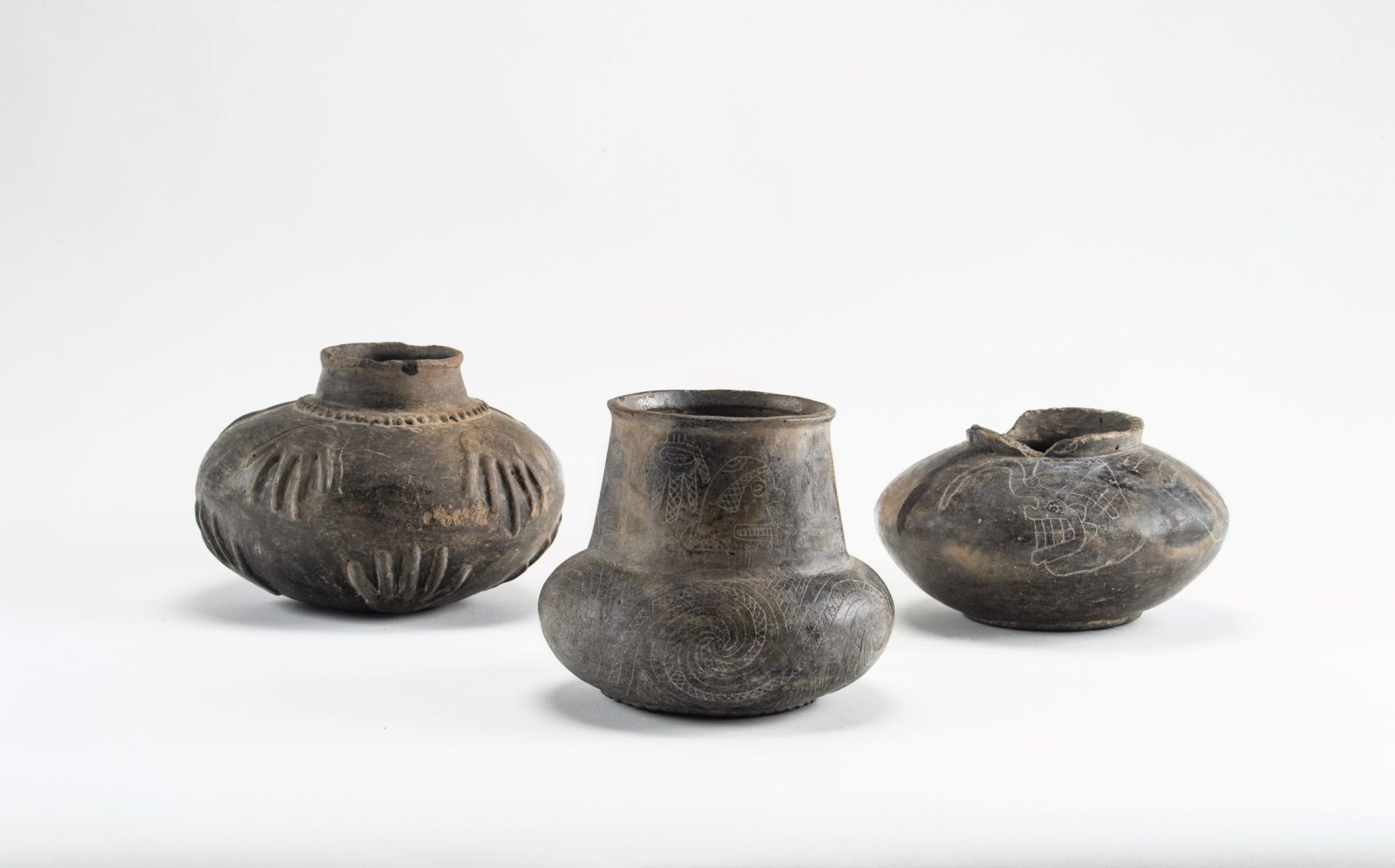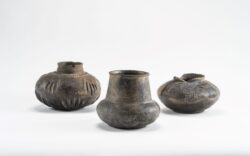Mississippian Culture
The Mississippian culture spanned from roughly 1050 to 1700 CE

Courtesy of Department of Sociology and Anthropology Archaeology Laboratory, University of Mississippi, Davies Collection 3359
Bottle with long-nosed god decorations, bowl with hand appliqués, and engraved jar.
Mississippian culture, which originated at the great urban center of Cahokia (near St. Louis), involved new social hierarchies and political structures that are reflected not only in rituals and symbols but also in pots and food items. Archaeologists use the presence of certain symbols on artifacts, along with shell-tempering in pottery and a reliance on maize agriculture, to trace the spread of Mississippian influence in the southeastern United States. Different groups adopted the new practices to a greater or lesser degree. In Louisiana, the influence of Mississippian culture was evident by 1200 CE. Native Americans living in Louisiana at this time are associated with Caddo and Plaquemine cultures. Discussions of these cultures can be found in their respective essays. This essay contains a description of some aspects of Mississippian culture outside of Louisiana, to provide a better background for descriptions of Mississippi-period peoples in Louisiana. Mississippian culture sites are not common in Louisiana, but a few of the sites that might have been occupied by Mississippians are reviewed.
Mississippian Culture: Definition
The expansion of Mississippian culture from circa 1050 to 1200 CE involved major realignments in many aspects of American Indian life. Cultural traditions at Cahokia involved dramatic changes in subsistence, artifacts, architecture, organization of space, settlement locations, public feasts, and mortuary rituals. By 1050 CE, these ingredients coalesced, perhaps around a religious leader of a lunar cult, producing an explosive flashpoint—metaphorically described by one archaeologist as a “Big Bang”—of culture change. These changes reverberated throughout much of eastern North America.
Recognizable aspects of Mississippian culture emanated from Cahokia to most regions of the Southeast, including parts of Louisiana, by 1200 CE. Archaeologists trace the spread of Mississippian culture using many different attributes, but among the most commonly used are the presence of pottery with shell added as temper (temper improves pottery quality); pots and other items bearing a special set of symbols; and the spread of maize (corn) as a dietary staple. However, as discussed for the Transylvania site below, distinguishing a Mississippian culture site from a Plaquemine culture site with some Mississippian influence is difficult, and involves more than a simple presence-or-absence accounting of traits.
Mississippian Pottery: Shell Temper
Shell-tempered pottery is arguably the most pervasive artifact of Mississippian culture. Although a minor amount of shell was present in the pottery made by earlier cultures in the southeastern United States, shell was used widely, and in many areas exclusively, in the Mississippi period after circa 1000 CE. Shell tempering may have been widely adopted because it was functional. Shell is a particularly good temper for backswamp clays like those in the Lower Mississippi River Valley. These clays are very fine-grained, and shrink excessively when dried. While other tempers like grog (the traditional temper in Louisiana) and sand also improve clay workability, the chemicals released by the shell during firing reduce the temperature at which fine silicates in the clay vitrify (turn glassy), and they also reduce shrinkage. The result is a clay that allows the potter to make a thinner, harder vessel, and to create more elaborate vessel forms.
Mississippian Pottery: Symbolism
Mississippian pots, along with many other utilitarian and ritual items, were decorated with a set of symbols that evoked cosmological concepts—ideas about the society’s place in the universe. These ideas were manifested in beautiful objects of stone, copper, clay, shell, and other materials. The cosmological concepts were inherent in a limited set of symbols, which were executed with infinite variations. While archaeologists are still debating the meanings of the symbols, they do understand some. One symbol, the cross-in-circle, illustrates the world, suspended from the sky by cords located at the cardinal directions. The hand-and-eye motif represents a constellation of stars (the hand) that is very close to the horizon and a portal (the eye). This motif is a depiction of the pathway an individual takes after death. The deceased leaps into the hand and through the portal to connect with the Path of Souls (the Milky Way).
Other items, possibly used as badges by the elite, show individuals engaged in games or at war (games were called “little wars” by historic American Indian groups, so these can be difficult to distinguish in prehistoric imagery). Archaeologists disagree about whether the individuals depicted represent the Mississippian elite, culture heroes, mythic heroes, or gods. Regardless, these images give excellent information on ceremonial regalia. The complexity of the costumes and designs suggests to some that there was Mesoamerican influence at this time. However, there is no concrete evidence of direct contacts between the Mississippian Southeast and Mesoamerica.
Mississippian Diet: Maize Agriculture
Certainly there was indirect contact between Mesoamerica and the Southeast in the precolonial past. Corn, or maize, was indisputably domesticated in Mesoamerica thousands of years before it became a Mississippian staple. Maize did not become an important part of the Southeastern diet until around 1000 CE, when it was incorporated into preexisting gardens of domesticated squash and seed plants such as little barley and goosefoot (lambsquarters).
In some areas of Louisiana, maize was adopted as a food source relatively early—the Caddo grew maize along with native plants by 900 CE. Other precolonial cultures in Louisiana adopted maize much later, perhaps initially for ceremonial uses. There is evidence for maize in ritual contexts—for instance at the terminal Coles Creek period Lake Providence Mounds site—by 1150 CE. In the best-studied Plaquemine culture village in south Louisiana, the Discovery site, corn was present but was not a staple even as late as circa 1500 CE.
Mississippian Intrusions
In describing Mississippian culture in Louisiana, it is sometimes possible to draw a distinction between Plaquemine culture sites with Mississippian influence and sites that were occupied by intrusive Mississippian culture peoples, although distinguishing the two can get complicated. The best evidence for determining cultural occupations is a combination of cultural artifacts and settlement patterns. The three examples presented here, the Transylvania, Salt Mine Valley, and Sims sites, are all late, occurring in what archaeologists call the “protohistoric” or early colonial period, when Europeans were present but their direct contact with American Indians was limited.
The Transylvania mound site is in East Carroll Parish. The site contains a Plaquemine component with Mississippian influence, as evidenced by a mixed grog-tempered and shell-tempered pottery assemblage. However, overlying this component was a later assemblage composed almost completely of shell-tempered pottery. In addition, in its final form, the site contained twelve mounds defining a double plaza. The double-plaza design is shared by some of the Plaquemine culture sites in Mississippi, like Winterville and Lake George in western Mississippi, but these sites are earlier than the Mississippian component at Transylvania, which dates to circa 1500 CE. The final occupation at Transylvania may represent a late migration of Mississippian people down the Mississippi River into Louisiana. However, some archaeologists argue that the shell-tempered pottery assemblage at Transylvania owes more to Plaquemine culture precedents than Mississippian culture innovations. These archaeologists suggest that, rather than an intrusion of Mississippian people, there was a more complex interplay between Plaquemine and Mississippian cultures in this area. They contend that, as in most other parts of Louisiana, Plaquemine culture ideals ultimately held sway.
The second example of a Mississippian intrusion is seen at the southern end of the state, at the Salt Mine Valley site on Avery Island. In this instance, the movement of people appears to be on a seasonal basis, and largely directed towards one activity—salt-making. There is evidence of salt-making at salines in several areas of the Southeast, including in Caddo territory, during the Mississippi period. The briny waters from a saline on Avery Island attracted one or more Mississippian culture groups from the Tensas River Valley or Lower Yazoo Basin around 1550–1650 CE. (The designs on some of the shell-tempered pottery match designs commonly found in those areas.) That salt production took place is apparent by the literal pavement of broken bowls and other briquetage (by-products of salt-making) in Salt Mine Valley. The undecorated bowls were filled with briny water and placed on top of fired clay cylinders over a low fire. The water evaporated, leaving the salt behind. The salt was then packed into smaller vessels for transport.
There is other evidence for Mississippian influence in extreme southeastern Louisiana, again mostly in the form of shell-tempered pottery and Mississippian designs that appear on both shell- and grog-tempered vessels. Sites like Sims Place (St. Charles Parish), Buras (Plaquemines Parish), Berwick (St. Mary Parish), and Magnolia Mound (St. Bernard Parish) are commonly cited when Mississippian sites in Louisiana are discussed. However, except for Sims, little is known about these sites. Like Transylvania, Sims had a Plaquemine culture component that exhibited some Mississippian influence, but also may have had a later Mississippian culture occupation dating to circa 1500–1700 CE. Somewhere between four and six mounds (three of which remain) defined a single plaza at Sims. Shell-tempered pottery and other artifacts (such as a chunkey stone) suggest the people living there may have been affiliated with the Mississippian center at the Bottle Creek site in Alabama
Final Thoughts
Mississippian culture made some inroads in the extreme northeast and southeast areas of Louisiana. But the main material manifestation of this is shell-tempered pottery, which never penetrated far from the northeastern and southeastern borders of Louisiana. Maize agriculture did not become the dietary staple that it was for Mississippian peoples elsewhere. Most tellingly, no burials have been found that have the abundance and kinds of high-status artifacts found at major Mississippian sites in the Southeast. There was a strong conservative core among most of the Plaquemine culture peoples in Louisiana who ignored or maybe even actively resisted the lifestyles or worldviews of Mississippian culture.
